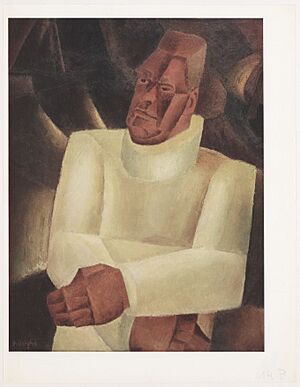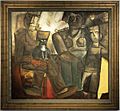Constant Permeke facts for kids
Constant Permeke (born July 31, 1886 – died January 4, 1952) was a famous Belgian painter and sculptor. He is known as the most important artist of Flemish expressionism. This art style shows strong feelings and ideas rather than just what things look like.
Contents
Biography of Constant Permeke
Permeke was born in Antwerp, Belgium. When he was six, his family moved to Ostend, a city by the sea. His father was also a painter and started the Municipal Museum of Arts there in 1893. He became the museum's boss.
Early Life and Studies
Permeke studied art at the Bruges Academy from 1903 to 1906. Then he went to the Academy in Ghent from 1906 to 1908. There, he met other artists like Frits Van den Berghe and the brothers Gustave De Smet and Léon De Smet.
He joined the Belgian army for a short time. After his army service, he returned to Ostend in 1908. In 1909, he moved to Sint-Martens-Latem, living a quiet life. His art from this time used thick brushstrokes and dark colors. It showed strong feelings with rough shapes. In 1912, Permeke married Maria Delaere, and they lived in Ostend.
World War I and Its Impact
When World War I began, Permeke joined the army. He was hurt during a battle near Duffel. Because of his injuries, he was sent to a hospital in the United Kingdom. After leaving the hospital, he met his family in Folkestone, where his son John was born.
In 1916, he moved to Chardstock in Devon. He started painting again, creating colorful pictures of English landscapes.
Return to Belgium and New Art Themes
After the war ended, the Permeke family went back to Ostend in 1919. Life was harder there than in Devon. Permeke's art became darker again. He mostly painted the tough lives of fishermen.
In 1921, Permeke showed his art in Antwerp and Paris. From 1922 to 1924, he often worked with Frits Van den Berghe in Astene. In 1926, Permeke visited Vevey in Switzerland, where he painted many mountain scenes.
Moving to Jabbeke and Later Works
In 1929, he moved to Jabbeke. Here, his art changed. Instead of fishermen and the sea, he painted farmers and their land. He created many famous works during this time, like "Gouden Oogst" (Golden Harvest) in 1935 and "Moederschap" (Motherhood) in 1936.
Starting in 1937, Permeke also began making sculptures. As a sculptor, he focused on making large, powerful human figures. Good examples are "De Zaaier" (The Sower) from 1939 and "Niobe" from 1946.
World War II and Later Life
During World War II, the German occupiers did not allow Permeke to paint. They called his art Entartete Kunst, meaning "degenerate art," which they thought was bad. His son Paul was also arrested and sent to work in Germany.
After the war, Permeke became the director of the Royal Academy in Antwerp. But he resigned after only one year. In 1947–48, he had a big art show in Paris. His son returned safely, but then his wife died in 1948. This made Permeke very sad and ill. His daughter had to take care of him.
In his last years, his art became softer with more detailed drawings and colors. His final works include "De dame met de rode handschoenen" (The Lady with the Red Gloves) from 1951. He also painted landscapes in Brittany. After his trip there in 1951, his health got worse, and he became bedridden.
Constant Permeke passed away on January 4, 1952. He was buried next to his wife in Jabbeke. A statue made by his friend George Minne was placed on his wife's grave.
Honours
- 1922: He was made an Officer in the Order of Leopold.
Commemoration
In 1997, Belgium honored Permeke by putting his picture and one of his artworks on the 1,000 Belgian franc bill.
Images for kids
See also
 In Spanish: Constant Permeke para niños
In Spanish: Constant Permeke para niños










